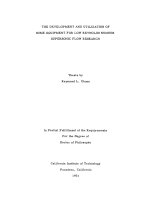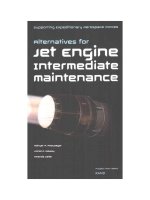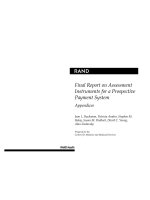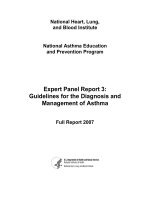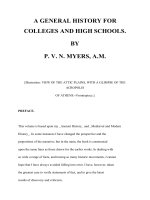NCHRP REPORT 509 Equipment for Collecting Traffic Load Data potx
Bạn đang xem bản rút gọn của tài liệu. Xem và tải ngay bản đầy đủ của tài liệu tại đây (660.26 KB, 68 trang )
Equipment for
Collecting Traffic
Load Data
NATIONAL
COOPERATIVE
HIGHWAY
RESEARCH
PROGRAM
NCHRP
REPORT 509
TRANSPORTATION RESEARCH BOARD EXECUTIVE COMMITTEE 2004 (Membership as of January 2004)
OFFICERS
Chair: Michael S. Townes, President and CEO, Hampton Roads Transit, Hampton, VA
Vice Chair: Joseph H. Boardman, Commissioner, New York State DOT
Executive Director: Robert E. Skinner, Jr., Transportation Research Board
MEMBERS
MICHAEL W. BEHRENS, Executive Director, Texas DOT
SARAH C. CAMPBELL, President, TransManagement, Inc., Washington, DC
E. DEAN CARLSON, Director, Carlson Associates, Topeka, KS
JOHN L. CRAIG, Director, Nebraska Department of Roads
DOUGLAS G. DUNCAN, President and CEO, FedEx Freight, Memphis, TN
GENEVIEVE GIULIANO, Director, Metrans Transportation Center and Professor, School of Policy, Planning, and Development,
USC, Los Angeles
BERNARD S. GROSECLOSE, JR., President and CEO, South Carolina State Ports Authority
SUSAN HANSON, Landry University Professor of Geography, Graduate School of Geography, Clark University
JAMES R. HERTWIG, President, Landstar Logistics, Inc., Jacksonville, FL
HENRY L. HUNGERBEELER, Director, Missouri DOT
ADIB K. KANAFANI, Cahill Professor of Civil Engineering, University of California, Berkeley
RONALD F. KIRBY, Director of Transportation Planning, Metropolitan Washington Council of Governments
HERBERT S. LEVINSON, Principal, Herbert S. Levinson Transportation Consultant, New Haven, CT
SUE MCNEIL, Director, Urban Transportation Center and Professor, College of Urban Planning and Public Affairs,
University of Illinois, Chicago
MICHAEL D. MEYER, Professor, School of Civil and Environmental Engineering, Georgia Institute of Technology
KAM MOVASSAGHI, Secretary of Transportation, Louisiana Department of Transportation and Development
CAROL A. MURRAY, Commissioner, New Hampshire DOT
JOHN E. NJORD, Executive Director, Utah DOT
DAVID PLAVIN, President, Airports Council International, Washington, DC
JOHN REBENSDORF, Vice President, Network and Service Planning, Union Pacific Railroad Co., Omaha, NE
PHILIP A. SHUCET, Commissioner, Virginia DOT
C. MICHAEL WALTON, Ernest H. Cockrell Centennial Chair in Engineering, University of Texas, Austin
LINDA S. WATSON, General Manager, Corpus Christi Regional Transportation Authority, Corpus Christi, TX
MARION C. BLAKEY, Federal Aviation Administrator, U.S.DOT (ex officio)
SAMUEL G. BONASSO, Acting Administrator, Research and Special Programs Administration, U.S.DOT (ex officio)
REBECCA M. BREWSTER, President and COO, American Transportation Research Institute, Smyrna, GA (ex officio)
GEORGE BUGLIARELLO, Chancellor, Polytechnic University and Foreign Secretary, National Academy of Engineering
(ex officio)
THOMAS H. COLLINS (Adm., U.S. Coast Guard), Commandant, U.S. Coast Guard (ex officio)
JENNIFER L. DORN, Federal Transit Administrator, U.S.DOT (ex officio)
ROBERT B. FLOWERS (Lt. Gen., U.S. Army), Chief of Engineers and Commander, U.S. Army Corps of Engineers (ex officio)
EDWARD R. HAMBERGER, President and CEO, Association of American Railroads (ex officio)
JOHN C. HORSLEY, Executive Director, American Association of State Highway and Transportation Officials (ex officio)
RICK KOWALEWSKI, Deputy Director, Bureau of Transportation Statistics, U.S.DOT (ex officio)
WILLIAM W. MILLAR, President, American Public Transportation Association (ex officio)
MARY E. PETERS, Federal Highway Administrator, U.S.DOT (ex officio)
SUZANNE RUDZINSKI, Director, Transportation and Regional Programs, U.S. Environmental Protection Agency (ex officio)
JEFFREY W. RUNGE, National Highway Traffic Safety Administrator, U.S.DOT (ex officio)
ALLAN RUTTER, Federal Railroad Administrator, U.S.DOT (ex officio)
ANNETTE M. SANDBERG, Federal Motor Carrier Safety Administrator, U.S.DOT (ex officio)
WILLIAM G. SCHUBERT, Maritime Administrator, U.S.DOT (ex officio)
ROBERT A. VENEZIA, Program Manager of Public Health Applications, National Aeronautics and Space Administration
(ex officio)
NATIONAL COOPERATIVE HIGHWAY RESEARCH PROGRAM
Transportation Research Board Executive Committee Subcommittee for NCHRP
MICHAEL S. TOWNES, Hampton Roads Transit, Hampton, VA
(Chair)
JOSEPH H. BOARDMAN, New York State DOT
GENEVIEVE GIULIANO, University of Southern California,
Los Angeles
JOHN C. HORSLEY, American Association of State Highway and
Transportation Officials
MARY E. PETERS, Federal Highway Administration
ROBERT E. SKINNER, JR., Transportation Research Board
C. MICHAEL WALTON, University of Texas, Austin
TRANSPORTATION RESEARCH BOARD
WASHINGTON, D.C.
2004
www.TRB.org
NATIONAL COOPERATIVE HIGHWAY RESEARCH PROGRAM
NCHRP REPORT 509
Research Sponsored by the American Association of State Highway and Transportation Officials
in Cooperation with the Federal Highway Administration
SUBJECT AREAS
Planning and Administration • Pavement Design, Management, and Performance •
Bridges, Other Structures, and Hydraulics and Hydrology
Equipment for
Collecting Traffic
Load Data
MARK H
ALLENBECK
Washington State Transportation Center
University of Washington
Seattle, WA
AND
HERBERT WEINBLATT
Cambridge Systematics, Inc.
Chevy Chase, MD
NATIONAL COOPERATIVE HIGHWAY RESEARCH
PROGRAM
Systematic, well-designed research provides the most effective
approach to the solution of many problems facing highway
administrators and engineers. Often, highway problems are of local
interest and can best be studied by highway departments
individually or in cooperation with their state universities and
others. However, the accelerating growth of highway transportation
develops increasingly complex problems of wide interest to
highway authorities. These problems are best studied through a
coordinated program of cooperative research.
In recognition of these needs, the highway administrators of the
American Association of State Highway and Transportation
Officials initiated in 1962 an objective national highway research
program employing modern scientific techniques. This program is
supported on a continuing basis by funds from participating
member states of the Association and it receives the full cooperation
and support of the Federal Highway Administration, United States
Department of Transportation.
The Transportation Research Board of the National Academies
was requested by the Association to administer the research
program because of the Board’s recognized objectivity and
understanding of modern research practices. The Board is uniquely
suited for this purpose as it maintains an extensive committee
structure from which authorities on any highway transportation
subject may be drawn; it possesses avenues of communications and
cooperation with federal, state and local governmental agencies,
universities, and industry; its relationship to the National Research
Council is an insurance of objectivity; it maintains a full-time
research correlation staff of specialists in highway transportation
matters to bring the findings of research directly to those who are in
a position to use them.
The program is developed on the basis of research needs
identified by chief administrators of the highway and transportation
departments and by committees of AASHTO. Each year, specific
areas of research needs to be included in the program are proposed
to the National Research Council and the Board by the American
Association of State Highway and Transportation Officials.
Research projects to fulfill these needs are defined by the Board, and
qualified research agencies are selected from those that have
submitted proposals. Administration and surveillance of research
contracts are the responsibilities of the National Research Council
and the Transportation Research Board.
The needs for highway research are many, and the National
Cooperative Highway Research Program can make significant
contributions to the solution of highway transportation problems of
mutual concern to many responsible groups. The program,
however, is intended to complement rather than to substitute for or
duplicate other highway research programs.
Note: The Transportation Research Board of the National Academies, the
National Research Council, the Federal Highway Administration, the American
Association of State Highway and Transportation Officials, and the individual
states participating in the National Cooperative Highway Research Program do
not endorse products or manufacturers. Trade or manufacturers’ names appear
herein solely because they are considered essential to the object of this report.
Published reports of the
NATIONAL COOPERATIVE HIGHWAY RESEARCH PROGRAM
are available from:
Transportation Research Board
Business Office
500 Fifth Street, NW
Washington, DC 20001
and can be ordered through the Internet at:
/>Printed in the United States of America
NCHRP REPORT 509
Project 1-39 FY’00
ISSN 0077-5614
ISBN 0-309-08788-0
Library of Congress Control Number 2004100961
© 2004 Transportation Research Board
Price $20.00
NOTICE
The project that is the subject of this report was a part of the National Cooperative
Highway Research Program conducted by the Transportation Research Board with the
approval of the Governing Board of the National Research Council. Such approval
reflects the Governing Board’s judgment that the program concerned is of national
importance and appropriate with respect to both the purposes and resources of the
National Research Council.
The members of the technical committee selected to monitor this project and to review
this report were chosen for recognized scholarly competence and with due
consideration for the balance of disciplines appropriate to the project. The opinions and
conclusions expressed or implied are those of the research agency that performed the
research, and, while they have been accepted as appropriate by the technical committee,
they are not necessarily those of the Transportation Research Board, the National
Research Council, the American Association of State Highway and Transportation
Officials, or the Federal Highway Administration, U.S. Department of Transportation.
Each report is reviewed and accepted for publication by the technical committee
according to procedures established and monitored by the Transportation Research
Board Executive Committee and the Governing Board of the National Research
Council.
The National Academy of Sciences is a private, nonprofit, self-perpetuating society of distinguished schol-
ars engaged in scientific and engineering research, dedicated to the furtherance of science and technology
and to their use for the general welfare. On the authority of the charter granted to it by the Congress in
1863, the Academy has a mandate that requires it to advise the federal government on scientific and techni-
cal matters. Dr. Bruce M. Alberts is president of the National Academy of Sciences.
The National Academy of Engineering was established in 1964, under the charter of the National Acad-
emy of Sciences, as a parallel organization of outstanding engineers. It is autonomous in its administration
and in the selection of its members, sharing with the National Academy of Sciences the responsibility for
advising the federal government. The National Academy of Engineering also sponsors engineering programs
aimed at meeting national needs, encourages education and research, and recognizes the superior achieve-
ments of engineers. Dr. William A. Wulf is president of the National Academy of Engineering.
The Institute of Medicine was established in 1970 by the National Academy of Sciences to secure the
services of eminent members of appropriate professions in the examination of policy matters pertaining to
the health of the public. The Institute acts under the responsibility given to the National Academy of
Sciences by its congressional charter to be an adviser to the federal government and, on its own initiative,
to identify issues of medical care, research, and education. Dr. Harvey V. Fineberg is president of the
Institute of Medicine.
The National Research Council was organized by the National Academy of Sciences in 1916 to associate
the broad community of science and technology with the Academy’s purposes of furthering knowledge and
advising the federal government. Functioning in accordance with general policies determined by the Acad-
emy, the Council has become the principal operating agency of both the National Academy of Sciences and
the National Academy of Engineering in providing services to the government, the public, and the scientific
and engineering communities. The Council is administered jointly by both the Academies and the Institute
of Medicine. Dr. Bruce M. Alberts and Dr. William A. Wulf are chair and vice chair, respectively, of the
National Research Council.
The Transportation Research Board is a division of the National Research Council, which serves the
National Academy of Sciences and the National Academy of Engineering. The Board’s mission is to promote
innovation and progress in transportation through research. In an objective and interdisciplinary setting, the
Board facilitates the sharing of information on transportation practice and policy by researchers and
practitioners; stimulates research and offers research management services that promote technical
excellence; provides expert advice on transportation policy and programs; and disseminates research
results broadly and encourages their implementation. The Board’s varied activities annually engage more
than 4,000 engineers, scientists, and other transportation researchers and practitioners from the public and
private sectors and academia, all of whom contribute their expertise in the public interest. The program is
supported by state transportation departments, federal agencies including the component administrations of
the U.S. Department of Transportation, and other organizations and individuals interested in the
development of transportation. www.TRB.org
www.national-academies.org
COOPERATIVE RESEARCH PROGRAMS STAFF FOR NCHRP REPORT 509
ROBERT J. REILLY, Director, Cooperative Research Programs
CRAWFORD F. JENCKS, Manager, National Cooperative Highway Research Program
AMIR N. HANNA, Senior Program Officer
EILEEN P. DELANEY, Managing Editor
BETH HATCH, Assistant Editor
ELLEN M. CHAFEE, Assistant Editor
NCHRP PROJECT 1-39 PANEL
Field of Design—Area of Pavements
DANNY A. DAWOOD, Pennsylvania DOT (Chair)
KENNETH W. FULTS, Texas DOT
CHARLES K. CEROCKE, Nevada DOT
HARSHAD DESAI, Florida DOT
RALPH A. GILLMANN, FHWA
JERRY LEGG, West Virginia DOT
TED SCOTT, Roadway Express, Inc., Alexandria, VA
ANDREW WILLIAMS, JR., Ohio DOT
LARRY WISER, FHWA Liaison Representative
STEPHEN F. MAHER, TRB Liaison Representative
A. ROBERT RAAB, TRB Liaison Representative
This report identifies the key issues that must be considered by state and other high-
way operating agencies in selecting traffic equipment for collecting the truck volumes
and load spectra needed for analysis and design of pavement structures. The report also
identifies steps that must be taken to ensure that the equipment performs appropriately
and that, as a consequence, the data collected accurately describe the vehicles being
monitored. The report is a useful resource for state personnel and others involved in the
planning and design of highway pavements and structures.
Traffic information is one of the key data elements required for the design and
analysis of pavement structures. In the procedure used in the 1993 AASHTO Guide for
Design of Pavement Structures, a mixed traffic stream of different axle loads and axle
configurations is converted into a design traffic number by converting each expected
axle load into an equivalent number of 18-kip, single-axle loads, known as equivalent
single-axle loads (ESALs). Equivalency factors are used to determine the number of
ESALs for each axle load and axle configuration. These factors are based on the pres-
ent serviceability index (PSI) concept and depend on the pavement type and structure.
Studies have shown that these factors also are influenced by pavement condition, dis-
tress type, failure mode, and other parameters.
A more direct and rational approach to the analysis and design of pavement struc-
tures involves procedures that use mechanistic-empirical principles to estimate the
effects of actual traffic on pavement response and distress. This approach has been used
to develop a guide for the mechanistic-empirical design of new and rehabilitated pave-
ment structures as part of NCHRP Project 1-37A. The mechanistic-based distress pre-
diction models used in this guide will require specific data for each axle type and axle
load group. Recognizing the constraints on resources available in state and local high-
way agencies for traffic data collection, the guide will allow for various levels of traf-
fic data collection and analysis.
Because the anticipated guide will use traffic data inputs that differ from those cur-
rently used in pavement design and analysis, there was an apparent need for research
to provide clear information on traffic data and forecasting and to provide guidance on
selection and operation of the equipment needed for collecting these data. This infor-
mation will facilitate use of the anticipated guide. NCHRP Project 1-39 was conducted
to address this need.
Under NCHRP Project 1-39, “Traffic Data Collection, Analysis, and Forecasting
for Mechanistic Pavement Design,” Cambridge Systematics, Inc., was assigned the
objectives of (1) developing guidelines for collecting and forecasting traffic data to
formulate load spectra for use in procedures proposed in the guide for mechanistic-
empirical design and (2) providing guidance on selecting, installing, and operating traf-
fic data collection equipment and handling traffic data. This report is concerned with
FOREWORD
By Amir N. Hanna
Staff Officer
Transportation Research
Board
the latter objective; the first objective will be addressed in detail in the agency’s final
report on the project.
To accomplish the latter objective, the researchers identified the steps required to
select the equipment necessary for collecting traffic load data. In these steps, the
researchers identified the types of equipment available for collecting classification
counts and for weighing vehicles in motion and provided detailed descriptions of var-
ious technologies. As part of these descriptions, the researchers reviewed the strengths
and weaknesses of each technology. Finally, the researchers provided guidance on
selection of equipment by considering (1) data collection needs of users, (2) data han-
dling requirements and capabilities, and (3) characteristics of available technologies.
To facilitate implementation and use of equipment, the researchers also provided infor-
mation on best practices for equipment use.
The information contained in this report should be of interest to those involved in
the planning and design of highway pavements and structures. It will be particularly
useful to agencies contemplating collection of traffic data for use in conjunction with
the guide for the mechanistic-empirical design of new and rehabilitated pavement
structures.
1SUMMARY
16 CHAPTER 1 Introduction
17 CHAPTER 2 Types of Equipment
2.1 Vehicle Classification, 17
2.2 WIM Data, 18
21 CHAPTER 3 Technology Descriptions
3.1 Vehicle Classification, 21
3.2 WIM, 33
41 CHAPTER 4 A Process for Selecting Equipment
4.1 Data Collection Needs, 41
4.2 Data Handling and Other Agency Considerations, 43
4.3 Understanding Equipment Characteristics, 43
46 CHAPTER 5 Best Practices for Equipment Use
5.1 Identify User Requirements, 46
5.2 Determine Site Location and System Requirements, 47
5.3 Determine Design Life and Accuracy Requirements, 48
5.4 Budget Necessary Resources, 49
5.5 Develop, Use, and Maintain a Quality Assurance Program, 50
5.6 Purchase Equipment with a Warranty, 52
5.7 Manage Equipment Installation, 53
5.8 Calibrate and Maintain Calibration of Equipment, 53
5.9 Conduct Preventive and Corrective Maintenance, 57
CONTENTS
The traffic load data that are key to the design of pavement structures include truck
volumes and the load spectra for those volumes. These data are obtained by counting
trucks by class and by weighing a sample of trucks to obtain the load spectra associ-
ated with each class of truck. Therefore, data collection equipment must allow for col-
lecting both types of data.
Weigh-in-motion (WIM) data collection equipment collects both truck volume and
load spectra, but the equipment is more expensive to obtain and more difficult to install
and operate than equipment that can only count and classify vehicles. Therefore, high-
way agencies routinely use a combination of WIM and simpler vehicle classification
equipment to collect the data they require for pavement design.
This report summarizes the key issues and information needed by a state or other
highway operating agency to select the equipment it needs to perform these tasks. It
also summarizes the steps that must be taken to ensure that the equipment selected
works as intended and that, as a consequence, the data collected accurately describe the
vehicle fleet being measured.
S.1 BASIC EQUIPMENT NEEDS
A combination of permanent and portable data collection is needed to provide the
traffic load data required for pavement design. Permanent devices provide more exten-
sive datasets and are generally necessary for collecting the data needed to understand
changes in traffic patterns associated with different days of the week and months of the
year. Portable devices allow flexibility in collecting data and help ensure that data are
collected from specific locations of interest. Portable devices also tend to lower the cost
of collecting the geographically diverse and site-specific data needed to develop accu-
rate pavement design loads.
Therefore, a combination of devices—WIM and classification, permanent and
portable—are needed to meet their traffic data collection needs for pavement design.
Further expanding the need for diversity in the devices that many states will purchase
and use is the fact that different technologies have different strengths and weaknesses.
Some equipment works nearly flawlessly in rural areas and in moderate environmental
SUMMARY
EQUIPMENT FOR COLLECTING
TRAFFIC LOAD DATA
conditions, but that same equipment may work poorly in urban stop-and-go traffic or
where snow conditions disrupt driver lane discipline. Other devices work less accu-
rately under the best of conditions but can still operate effectively in harsh data collec-
tion conditions such as stop-and-go traffic or adverse weather. Making these tradeoffs
is the most difficult part of selecting equipment.
To make these tradeoffs correctly, and then to ensure that the selected equipment
operates as intended, requires knowledge. Required areas of knowledge and necessary
decisions and/or actions include the following:
•
Understanding the equipment’s capabilities and limitations;
•
Understanding the data collection site’s characteristics;
•
Choosing data collection locations that provide the best opportunity for collecting
accurate data;
•
Selecting equipment for each site that can operate effectively in the traffic and
environmental conditions present at that site;
•
Understanding how data collected from two different devices relate to each other
(i.e., are the vehicle classes collected by two different classifiers the same, and if
not, how do those classes relate to each other?);
•
Installing the equipment correctly;
•
Understanding how to test the equipment once it is in place to ensure that it is oper-
ating as intended and ensuring that these procedures are followed;
•
Properly calibrating the equipment after it has been installed;
•
Understanding preventive and corrective “site” maintenance;
•
Performing quality control checks on the data produced by those devices; and
•
Repairing, re-calibrating, or otherwise adjusting the equipment and site conditions
if quality assurance checks indicate that problems are occurring.
While the choice of sensor technology can affect the accuracy of the data collected
as well as the cost and longevity of the data collection installation, a wide body of
research shows that technology is only one of many factors that affect the reliability of
collected data. In fact, recent work done for the Federal Highway Administration
(FHWA) concluded that “In general the differences between devices from different
manufacturers were more significant than differences between technologies.” The
report also stated that “It is more important to select a well designed and highly reli-
able product than to narrow a selection to a particular technology.”
1
This is not to say that technology choice is unimportant. Each technology has specific
strengths and weaknesses. Understanding those strengths and weaknesses allows a high-
way agency to select equipment that is more likely to work in a specific situation. While
different vendors are often capable of designing around a given technology’s weaknesses,
the odds of obtaining accurate data are certainly increased by taking advantage of spe-
cific technology strengths and avoiding known technology weaknesses. At the same time,
as noted in the aforementioned FHWA study, some vendors do a poor job of imple-
menting specific technologies. In addition, even the best technology from the best ven-
dor will not work accurately if the device is poorly installed, maintained, or calibrated.
The rest of this report describes an equipment selection process that guides interested
parties toward the technologies that have demonstrated (in the literature published to
date) specific strengths and away from technologies that have demonstrated specific
weaknesses. Note that (1) this review is not universal (some data collection technolo-
2
1
Field Test of Monitoring of Urban Vehicle Operations Using Non-Intrusive Technologies, FHWA, May 1997, FHWA-PL-97-018,
by Minnesota DOT and SRF Consulting.
3
gies have undoubtedly been missed) and (2) data collection technology continues to
evolve with time. Specific devices may come to market that are either not part of this
review or have different attributes from the technologies reviewed in this report. There-
fore, highway agencies are reminded to continually review available sources
2
that
describe equipment performance, to communicate frequently with neighboring states
to learn about the performance of their data collection equipment and their experiences
with vendors, and to monitor the performance of their equipment to ensure that it oper-
ates as intended.
S.2 SHORT-DURATION VEHICLE CLASSIFICATION EQUIPMENT
The primary technological attributes that should be considered when short-duration
vehicle classification equipment is selected include the following:
•
Whether the vehicle (tire) sensors need to be placed on the road surface or will
measure from above or beside the pavement,
•
The type of vehicle classes that can be collected by the device,
•
The number of lanes that each device can observe, and
•
The effects that specific environmental conditions will have on equipment perfor-
mance.
These attributes are summarized in Table S.1 for the technologies commonly found on the
market in 2002.
To select equipment, the highway agency must also consider the cost of the equip-
ment (capital, operations, maintenance, and other life-cycle cost considerations), the
ability to integrate the data collected by a specific device into the state’s traffic data
management system (how the vendor’s data retrieval software/system works and
whether it integrates easily with the state’s system), and the various support services
and assurances offered by specific vendors, including warranties and other guaranties
of performance, proof of previous successful performance (independent testing), the
level of technical support offered, and the availability of training. In many cases, these
additional factors are the deciding factor in equipment selection, especially when two
alternative technologies have similar operating characteristics.
All of the above factors are interrelated. In addition, each can be the deciding factor
in an equipment selection decision. Thus, no single piece of equipment is always the
best choice, and no single, simple decision process will lead to the correct equipment
choice. The state must weigh the relative importance of these attributes each time it
selects equipment.
S.2.1 Intrusive or Non-Intrusive Sensors
Perhaps the first question that should be asked when deciding between intrusive and
non-intrusive equipment is “Can the portable equipment be safely installed in the road-
way section in question?” In most cases, intrusive sensors provide more descriptive
vehicle classification data than non-intrusive sensors, especially where the sensors pro-
vide axle count and spacing information. They are therefore normally better options for
portable classification counts than non-intrusive sensors if they can be safely placed on
the road surface.
2
On-line resources are provided at the end of this summary, as are references to some conventionally published works.
TABLE S.1 Short-duration classification technology comparisons
5
However, if intrusive equipment cannot be safely installed in the roadway, by default,
the highway agency must consider non-intrusive
3
vehicle classification equipment,
even though that equipment places significant constraints on the types of truck classi-
fications that can be collected and limits the devices that are available for selection.
In some locations, the alternatives to non-intrusive sensors are “no data collection”
or “data collection only when full traffic control can be provided.”
S.2.2 Vehicle Classes Collected
The mechanistic-empirical pavement design software (which is being developed
under NCHRP Project 1-37A) uses the number of axles by axle configuration as an
input to the design process. Therefore, in general, data collection equipment that can
collect and classify vehicles by using axle count and axle spacing as inputs is prefer-
able over other classification equipment. Ideally, the classification procedure used by
a portable counter should match that used by WIM devices in the state. The highway
agency can accomplish this by supplying the vendor of a selected device with the clas-
sification algorithm used to convert axle count and spacing information into an esti-
mate of vehicle classification. It is strongly recommended that the equipment be able
to accept the specific classification algorithm that a state has tested and approved. (A
highway agency should also test to ensure that the correct algorithm has in fact been
installed and is operating as intended.)
There are cases in which axle-based truck classes cannot be collected (normally
because axle sensors cannot be safely placed on the roadway or because traffic flow is
unstable, and axle spacings cannot be accurately measured). Where these conditions
are expected, it is acceptable to select portable classification equipment that collects
truck volume data using other vehicle classes. This usually means classifying vehicles
by overall vehicle length. It is important, however, that the state be able to correlate
these classes to those used by its WIM system. States are not advised to purchase vehi-
cle classification equipment that produces volume estimates that cannot be correlated
effectively with their WIM data.
S.2.3 Lanes of Data Collected: Operational and Geometric Considerations
The next consideration in equipment selection is to understand how many traffic
lanes can be monitored by each piece of equipment. For sensors, this normally means
determining whether an individual sensor measures one or more lanes, and if more than
one lane, whether the data are reported for each lane individually or for all lanes com-
bined. For data collection electronics, this means understanding whether the device can
accept sensor inputs from more than one lane of traffic simultaneously.
Many of the older intrusive technologies (e.g., traditional road tubes) only collect
data in the outside lane of a facility when they are used as portable detectors. Others
(e.g., fiber-optic cable and the new multi-lane road tubes) can collect inside lane data,
but only when special precautions are taken to protect the sensor from being dislodged
by traffic in the adjacent lanes. When placed, these sensors must be carefully aligned
with the existing lane lines to collect accurate truck volume data.
Another concern with axle spaced-based classification counting is that unstable traf-
fic flow speed (stop-and-go traffic in particular) makes the output of many devices
3
If the number of these sites is small, the highway agency can also construct “permanent” sensor installations and then rotate data
collection electronics among these locations. However, for the purposes of this report, these are considered “permanent” devices and
are discussed later in the report.
unreliable. Technologies that can classify correctly without vehicles traveling at a con-
sistent speed are therefore required. These tend to use much broader vehicle classifi-
cation schemes because these broader schemes are less susceptible to minor errors in
length measurement. (Thus, simple length classifiers tend to classify more accurately
in congested road sections than do axle sensor-based devices.)
Both operational characteristics and the number of lanes to be counted are deter-
mined by the geometric configuration of the roadway. In some instances, more accu-
rate data for pavement design can be obtained by moving upstream or downstream of
a desired data collection location. While this makes the data collection site less site spe-
cific, it often allows for placement of data collection sensors on a road section with geo-
metric features that are more conducive to accurate classification counting. This is an
acceptable practice for use with TrafLoad (which is being developed under NCHRP
Project 1-39) and the pavement design software so long as the truck volumes collected
provide an accurate measure of the traffic crossing the pavement design section.
S.2.4 Environmental Considerations
Environmental conditions can degrade the performance of specific technologies, espe-
cially when those devices are used in a portable mode. For example, snow decreases vehi-
cles’ lane discipline and thus badly affects count and classification accuracy for most
lane-specific count technologies (although few portable devices are placed during
potential snow conditions).
Devices that must be taped to the road surface (tape switches, portable fiber-optic
cables, portable piezoelectric film or cable) often do not remain in place very long when
the sensors must be placed on wet pavement. Thus, in wet conditions, technologies such
as road tubes that can be held in place by pavement nails tend to be better choices. Non-
intrusive detection devices that are not affected by wet pavement conditions also tend
to perform better than these sensors.
However, non-intrusive detectors can be affected by other environmental factors.
For example, video detectors tend to work poorly when visibility is low (e.g., in heavy
snow, glare, dust storms, or fog). They make a poor choice for locations subject to these
environmental conditions. Infrared sensors have also been shown to perform poorly
when visibility is low. Some acoustic sensors have shown performance degradation in
cold weather.
S.3 PERMANENT VEHICLE CLASSIFICATION EQUIPMENT
For purposes of this report, “permanent” equipment is differentiated from “short-
duration” equipment both because permanent equipment requires more resources to
initially place and because its counting session can (but does not necessarily have to)
last longer. (That is, permanent equipment cannot be quickly placed at a location that
has not been prepared, while the short-duration equipment can.) Thus, devices that can
be slid in and out of a conduit placed under the pavement are considered permanent
because of the effort required to initially install the conduit, even though once that con-
duit has been laid, the sensors themselves can be placed or removed quickly.
The attributes of the alternative permanent vehicle classification technologies are
summarized in Table S.2. As with short-duration classification counters, these attributes
are only part of the information required to choose among alternative devices. In many
cases, the other considerations in equipment selection (price, vendor support, and war-
ranties) are even more important than the characteristics of the specific technologies.
6
TABLE S.2 Permanent classification technology comparisons
(continued on next page)
TABLE S.2 (Continued)
9
S.3.1 Choosing Between Intrusive and Non-Intrusive Sensors
As with short-duration classifiers, a key consideration is whether conditions require
the use of non-intrusive sensors. As with short-duration counts, the primary drawback
of non-intrusive sensors is that very few devices directly measure the number and con-
figuration of axles. This reduces the accuracy of vehicle classification count informa-
tion for the purpose of pavement design. However, there are conditions when this loss
of pavement design accuracy is warranted. These conditions occur where pavement or
environmental conditions would result in poor performance of intrusive, axle-based
classifiers or where location considerations reduce the cost of non-intrusive sensors sig-
nificantly relative to the cost of intrusive sensors.
For example, non-intrusive sensors are particularly advantageous for locations
where lane geometry will soon change. Because they are non-intrusive, changing the
focal point (the exact space at which the sensor points and collects data) for most non-
intrusive devices is fairly simple. This is not true for most permanently mounted, intru-
sive devices. Thus, if a roadway will be restriped as part of an ongoing, long-term con-
struction project, the choice of non-intrusive sensors makes sense. With intrusive
sensors, the sensors initially placed are generally useless in the new lane configuration
(they often cover parts of two lanes) and must be either dug up or abandoned. (Few sen-
sors can be dug up and then reused.) It makes far better economic sense to place non-
intrusive sensors in such a location, even though the data collected are less precise than
desired, rather than either not collect data or purchase and install two complete sets of
intrusive sensors.
With permanent counter equipment, usually the need for a long-term data collection
site makes a highway agency willing to perform the tasks necessary to install sensors
in the roadway on all lanes of a facility, regardless of roadway geometry. (For exam-
ple, the agency will cut slots in the outside lane pavement to protect lead wires leading
to sensors that monitor traffic on the inside lanes.) Thus, unlike with short-duration
counts, the geometric configuration of a roadway, by itself, is unlikely to cause a state
to select non-intrusive sensors over intrusive sensors.
On the other hand, because permanent equipment operates year-round, weather and
environmental sensitivity become bigger issues. In locations that experience frequent,
heavy snowfall and a resulting decline in driver lane discipline, considerable data can
be lost if lane-specific axle sensors are selected. In addition, with sensors that operate
year-round, states must determine whether the sensors they select will function in the
temperatures expected. For example, piezoceramic cable loses sensitivity in very cold
weather. Consequently, states that wish to place sensors in a location that will experi-
ence temperatures well below freezing must obtain both documented proof and war-
ranties from their vendors that the selected equipment will operate correctly at the
expected temperatures.
S.3.2 Sensor Longevity and Pavement Condition
A second situation in which non-intrusive sensors may be preferable to intrusive sen-
sors is where the pavement condition is poor enough now, or will be in the near future,
to raise doubts about the expected life of intrusive sensors and/or where the pavement
condition could affect the accuracy of those sensors.
Poor pavement condition can dramatically shorten the life span of intrusive sensors.
This is partly because poor pavement conditions increase vehicle dynamics, which in
turn increase the impact loads applied to intrusive sensors. But poor pavement condi-
tion also commonly leads to premature failure of the pavement/sensor bond, and the
loss of this bond normally results in a non-functional sensor (and often the loss of the
sensor itself, because most sensors cannot be reinstalled).
Even if the sensor has not failed, pavement failure around the sensor can lead to the
generation of “stray” signals within the sensor. One common form of these signals is
“ghost axles” generated in piezoelectric cables when neighboring concrete slabs rock
because of failure of the joints between slabs. Stray signals frequently result in mis-
classification of vehicles, collection of invalid vehicle records, and ultimately the cre-
ation of datasets containing so many invalid data that they become unusable.
If the pavement condition at a proposed permanent data collection site is poor, there
are three major options: repave the roadway section that will hold the sensor before
installing that sensor; choose a non-intrusive sensor whose performance is not affected
by pavement condition; or select a lower-cost intrusive sensor technology recognizing
that the life span of that sensor will be fairly short.
The last of these options is often a cost-effective way of collecting a valuable data-
set needed for very accurate pavement design, but it requires acknowledgment that the
sensor will be lost in a shorter period than most states expect their permanent equip-
ment to last. It also means that great care must to be taken to (1) review data from the
device placed at this location to ensure that it works accurately when it is originally
placed and then (2) identify when sensor accuracy starts to degrade as the pavement
condition continues to deteriorate. Therefore, in these conditions, added quality con-
trol and data review are needed both when the sensor is first installed and then as the
device continues to operate.
Pavement condition also changes how a highway agency might view the tradeoffs
between sensor cost and performance. Poor pavement condition will significantly
change the life-cycle of all intrusive technologies. (For example, in some cases sensors
will fail before they reach their expected life because of pavement condition.) When
pavement condition is poor or even marginal, paying more for a longer lived sensor
makes no sense because the sensor failure will not be a function of the sensor itself. Con-
sequently, pavement life should be considered when the life expectancy of a permanent
site is computed, and the cost/performance decision should be adjusted accordingly.
S.3.3 Vehicle Classes Collected
As with short-duration counts, the preferred vehicle classification scheme for per-
manent classifiers is axle based, which means that, all things being equal, intrusive, axle
sensor-based classifiers are the preferred technology for meeting the pavement design
guide requirements for traffic load data. In fact, use of equipment that provides truck vol-
umes that follow the same classification scheme as the state’s WIM devices results in the
most accurate traffic load datasets possible and is recommended whenever practical.
However, many of the functions for which permanent classification data are collected
(e.g., seasonal adjustment of short-duration counts) require only two or three classes of
trucks. Therefore, having permanent classifiers that collect only three or four classes of
vehicles is acceptable when axle-based classifiers are not practical or cost-effective.
Selecting a classifier technology that does not use the same classification algorithm
as the WIM scales selected requires a careful determination of how the classification
schemes of these alternative devices correlate.
S.4 WEIGH-IN-MOTION EQUIPMENT
It is not possible to provide a simple decision process for selecting WIM equipment.
In general, each highway agency must determine its own tradeoffs among the cost of
10
11
equipment and its installation, the cost of calibration, the expected life span of the WIM
sensor, and the expected life span (and structural performance) of the pavement into
which the equipment will be placed. These technical considerations must also be exam-
ined in light of the compatibility of the data retrieval capabilities offered by specific ven-
dors, how well those capabilities integrate with existing data collection software, the
warranties and other guaranties of performance offered with the equipment, the perfor-
mance history of that equipment and its vendor, and the support services offered by the
vendor. Key technology considerations are summarized in Table S.3. An important addi-
tional consideration is whether the equipment offered by a vendor has been indepen-
dently evaluated and found to meet the ASTM E 1318 WIM performance standards.
S.4.1 Technology Choice Versus Location Choice
The primary key to the success of any WIM system’s use is the location of the axle
weighing sensors. Because vehicle dynamics play such a significant role in the force
actually applied by any given axle at any given point on the roadway, the selection of
the location used to weigh trucks is often more important than the choice of a specific
technology to ensure accurate axle weight data. The placement of a scale in rough,
uneven pavement will result in poor quality weight data, regardless of the WIM tech-
nology selected. Similarly, if the pavement condition at a WIM site deteriorates after a
scale has been installed, the performance of that scale can be expected to deteriorate as
well, regardless of the technology selected.
Some scale sensor technologies rely on the structural strength of the pavement in
which they are supported. When these sensors are placed in weak pavement (i.e., pave-
ment that flexes), the accuracy of these sensors tends to degrade. Similarly, when the
strength of the pavement changes with environmental conditions (usually because of
changing moisture content or temperature), sensor performance can be expected to
change, and calibration drift frequently occurs. Consequently, where weight data are
needed for thinner, flexible pavements subject to changing strength characteristics,
selection of a WIM technology that separates the weight sensor from the pavement
through the use of some type of frame is a good idea. However, the pavement must be
thick enough to hold the frame. Where the pavement cannot support accurate WIM data
collection, the highway agency should consider moving the data collection site to a
location at which the WIM can function accurately.
Finally, as with permanent vehicle classifiers, the highway agency should consider
expected pavement life when determining the life expectancy of a WIM site, as well as
the implications of that life span for the WIM technology for that site. That is, the agency
should not spend a lot of money on a WIM device and installation where the pavement
will not support accurate weighing for more than 1 year. Similarly, more expensive,
longer lived WIM scales should be considered for placement in high-quality pavement,
where these devices can be expected to operate accurately for many years.
S.4.2 Portable Versus Permanent Scale Deployment
Ideally, as with classifiers, WIM equipment selection would be divided into both per-
manent and portable devices, because WIM data are also needed both at geographically
diverse locations and over long periods at some locations to measure seasonal and day-
of-week changes in vehicle characteristics. Because dynamic vehicle motion dramat-
ically affects WIM sensor output, each scale must be calibrated to each of the specific
locations where the weighing sensors are placed. Site-specific calibration is the only way
TABLE S.3 Weigh-in-motion technology comparisons
13
that the dynamic effects of the pavement leading to the scale sensor can be accounted
for in the WIM scale calibration.
The need for site-specific calibration means that portable scales must be calibrated
each time they are placed on the road surface. This roughly doubles the cost of setting
up a portable weighing session because calibration often takes as much staff time as (if
not more staff time than) portable sensor placement and pick up. When these calibration
costs are accounted for, many highway agencies find that portable WIM becomes cost
prohibitive relative to the use of “short-term permanent” WIM (placing WIM sensors
permanently in the ground, but only collecting data from the sensors periodically for
moderately short periods).
S.4.3 Temperature Sensitivity
Some WIM systems are sensitive to temperature. Piezoceramic and piezopolymer
sensors are both temperature sensitive (i.e., their signal strength for a given axle force
changes with temperature). While some vendors have developed compensation algo-
rithms to account for temperature sensitivity, these technologies are at a disadvantage
when placed in environments that include quickly changing temperatures.
Because the strength of asphalt pavements also changes as environmental conditions
change, the technologies that rely on direct structural support from the pavement itself
will perform less consistently in these pavements than at locations where the pave-
ment’s strength characteristics will not change (e.g., thicker asphalt and concrete sec-
tions). Also more successful will be WIM technologies whose axle sensor support is not
affected by changing environmental conditions.
S.4.4 Scale Sensor Width, Accuracy, and Installation Effects
The larger the size of the scale sensor, the longer a tire is in contact with the sensor
and the longer the period during which force is measured. This provides an accuracy
advantage to wider sensors in comparison with narrow sensors. (Note, however, that if
the scale grows too wide, such as with some bridge WIM installations, multiple vehi-
cles will be on the sensor at the same time, thus degrading weighing accuracy.) Very
narrow sensors also permit tires to “bridge” the sensor, meaning that at no point is the
entire weight of the tire supported solely by the sensor. This decreases the sensitivity
of the sensor and makes weighing accuracy more sensitive to environmental changes
in pavement strength.
A significant advantage of narrow strip sensors is that installation is far easier and
takes considerably less time than for wider sensors. As a result, these sensors tend to
be less expensive to install. They also tend to be less expensive per sensor than wider
sensors.
S.4.5 Number and Location of Sensors
The most common means of reducing inaccuracy in weighing caused by vehicle
dynamics is to weigh an axle at more than one location as it moves along a road. Increas-
ing the number of weight sensors used by a WIM device (when those sensors are placed
in series) allows a more complete analysis of vehicle dynamics and, consequently, pro-
vides a better estimate of each axle’s static weight. Thus, in general, the larger the num-
ber of sensors placed in series on the roadway, the more accurate the system will be. In
addition, having multiple sensors allows the failure of at least one sensor without the loss
of all WIM capability. Unfortunately, each extra scale sensor increases the cost of the
WIM system. Therefore, multi-sensor WIM systems tend to use less expensive, narrow
strip sensors.
Most multi-sensor systems marketed in the United States place two scale sensors in
series in the roadway. However, some vendors of wider bending plate sensors achieve
a similar weighing-in-series effect by staggering their half-lane sensors (weighing first
one side of the truck, and then the other side of the truck), rather than placing them side-
by-side. This, too, measures a greater range of the truck’s dynamic motion, increasing
the scale’s ability to account for vehicle dynamics.
Several European WIM tests have shown that further advances in WIM system accu-
racy can be obtained by using even more sensors. To date, the use of three or more sen-
sors in series has not been adopted in the United States for production weighing.
S.4.6 Location of the Sensor Relative to the Pavement Surface
Field tests to date have shown that the most accurate WIM systems have sensors that
are mounted flush with the existing road surface. Sensors that sit on top of the pave-
ment create their own bump (even a very small bump is bad) that increases vehicle
dynamics, which in turn decrease sensor accuracy. Sensors that are entirely covered by
pavement are affected by changes in pavement strength associated with changes in
environmental conditions. Changes in pavement profile (such as rut formation) that
decrease the smoothness of the transition from the pavement surface to the WIM sen-
sor surface cause impact loads and increased vehicle dynamics, both of which con-
tribute to loss of WIM system accuracy.
S.5 ADDITIONAL GENERAL GUIDANCE
While it is important to select technologies that can operate in the conditions in
which they are installed, a successful data collection program will also incorporate all
of the attributes presented below. Some of these attributes have not been mentioned in
the preceding sections but are explained more fully in the other chapters.
•
Make sure that the equipment selected can collect data that meet the users’
requirements.
•
For permanently placed equipment, match the design life of the equipment to the
(remaining) design life of the location (pavement) where it will be installed.
•
Make sure that the equipment selected can operate accurately at the location where
data are required.
•
Budget the necessary resources to install, calibrate, operate, and maintain the
equipment, including site preventive and corrective maintenance. (Under-funded
programs often collect poor data because the programs sacrifice quality for quan-
tity, thereby collecting “data” that are mostly noise, not information.)
•
Develop, use, and maintain a quality assurance program. This includes making
sure that equipment is properly calibrated when first installed, that data produced
by that equipment are regularly checked for quality, and that identification of sus-
pect data or equipment performance results in an investigation of the cause and
either confirms accurate system performance or results in repairs, replacement, or
removal of the malfunctioning equipment.
•
Select equipment that has passed an independent performance test (such as ASTM
E 1318) and for which vendors are willing to supply warranties of performance.
14
15
•
Make sure that the staff installing the equipment are fully trained in the installation
of that equipment and that they understand the factors that affect its performance.
•
Maintain a preventive and corrective maintenance program to ensure that data col-
lection equipment reaches its expected life and that the data provided are accurate.
S.6 RESOURCES
S.6.1 Paper Reports
American Society of Testing Materials, Annual Book of ASTM Standards 2000, Section 4, Construc-
tion, Volume 04.03, Designation: E 1318—Standard Specification for Highway Weigh-In-Motion
(WIM) Systems with User Requirements and Test Method.
Middleton, D., Jasek, D., and Parker, R., “Evaluation of Some Existing Technologies for Vehicle
Detection,” Project Summary Report 1715-S. Texas Transportation Institute, September 1999.
McCall, B., and Vodrazka Jr., W.C., States Successful Practices Weigh-In-Motion Handbook, Cen-
ter for Transportation Research and Education (CTRE), Iowa State University, December 15, 1997,
/>Skszek, Sherry, State-of-the-Art Report on Non-Traditional Traffic Counting Methods, Final Report
#503, Arizona Department of Transportation, October 2001.
S.6.2 On-Line Resources (accessible as of June 20, 2003)
The Vehicle Detector Clearinghouse at New Mexico State University />FHWA’s Demonstration Project 121 web site on Weigh-in-Motion Technology l.
gov/dp121/ maintained by Oak Ridge National Laboratory.
The European Weigh-in-Motion of Axles and Vehicles for Europe (WAVE) project web site, http://
wim.zag.si/wave/.
The Minnesota Guidestar Non-Intrusive Traffic Detection Tests />projects/nitd.html.
16
CHAPTER 1
INTRODUCTION
This report is designed to serve as a primer on the selec-
tion and use of equipment for counting and classifying vehi-
cles and for collecting data on their axle weights. The data
collected by this equipment are specifically required by the
mechanistic-empirical pavement design procedures being
developed under NCHRP Project 1-37A (Development of the
2002 Guide for the Design of New and Rehabilitated Pave-
ment Structures). These data are also required by other pro-
cedures that incorporate estimates of expected pavement
stresses into the design of pavements.
The most important finding of an extensive review of the
available literature on equipment performance is that wide
variation exists in the reported error rates for any given tech-
nology. In fact, different results are often reported for dif-
ferent tests of a specific device from the same manufacturer.
Closer examination of these results almost always leads to
the conclusion that the observed variation is a direct result of
differences in the environment in which the devices were
placed, as well as how well each specific piece of equipment
was placed, calibrated, maintained, and operated.
When the Minnesota Guidestar program examined non-
intrusive sensors,
1
one of its primary conclusions was that
“the differences between devices from different manufactur-
ers were more significant than differences between technolo-
gies.” The report also stated, “It is more important to select a
well designed and highly reliable product than to narrow a
selection to a particular technology.”
Taken together, these observations make it clear that no
single technology is best and that simply purchasing all data
collection equipment from a reputable vendor will not ensure
accurate data collection. Rather, the following is required:
•
A careful examination of equipment capabilities and lim-
itations relative to the data collection environment in
which that equipment will be placed and
•
The deployment of a comprehensive data collection pro-
gram that includes, at a minimum,
– Acceptance testing of purchased equipment;
– Staff training in that equipment’s placement, opera-
tion, and maintenance;
– Quality assurance tests on the data that are collected;
– The funding necessary to purchase and properly install,
inspect, maintain, and operate the equipment; and
– Sufficient vendor support to quickly resolve problems
identified as the equipment is used.
This report provides a basic overview of the steps required
to select the equipment necessary to collect traffic load data.
The report also discusses all these data collection program
attributes.
The report is organized into a summary and five chapters,
including this introduction. Chapter 2 provides a brief intro-
duction to the types of equipment available for collecting
classification counts and for weighing vehicles in motion, and
Chapter 3 contains more detailed descriptions of the various
technologies. Chapter 4 provides guidance on the selection
of equipment, and the final chapter offers additional guidance
on the implementation and use of the equipment.
1
Field Test of Monitoring of Urban Vehicle Operations Using Non-Intrusive Technolo-
gies, FHWA, May 1997, FHWA-PL-97-018, by Minnesota DOT and SRF Consulting.
